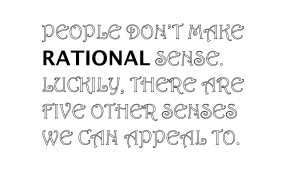I’ve always loved metaphor.
Analogy.
Simile.
Juxtaposition.
Metaphor is a way of helping explain the inexplicable.
It describes emotions and emotional connection in a way rational people could understand.
Metaphors paint pictures in the mind. Metaphors make language more sensory.
Metaphor makes sense to me.
As a result, I loved the idea of constructing brand identity through a human metaphor.
Not only did the correlation make sense to me, it sang of insight.
As marketers, we need to connect with people.
As customers, we are more likely to engage with communications that reeked of human truth and human foibles.
The Human Brand helps create brand structures that build consistency and relevance in the market.
It recognises and leverages the emotional triggers and drivers that connect customers to products.
It informs the behaviour of sales people and support staff.
And, by creating a brand based on emotion, it’s easier to create communications which tiptoe past the brain and waltz straight to the customer’s heart.
People buy with emotion.
They justify their purchase once their brain realises what their heart has done.
The Human Brand makes sense.
It seems only reasonable, if we build brands based on human foundations, we must expect brands to act like humans.
Some are good.
Some are not so good.
Some yell too much. Or talk about themselves too much. Or are overly pedantic. Or are too formal. Or seem to think nuance is a city in Croatia.
Some act honestly.
Some simply say what you want to hear while they rifle through your pockets looking for lost notes and small change.
While we, as brand custodians, want brands to be perfect, they can’t be.
But, as with humans, we love in spite of the imperfections.
In some cases, we love because of the imperfections.
We try so hard to be perfect.
Maybe we should be satisfied with being human.
Warts and all.


Leave A Comment